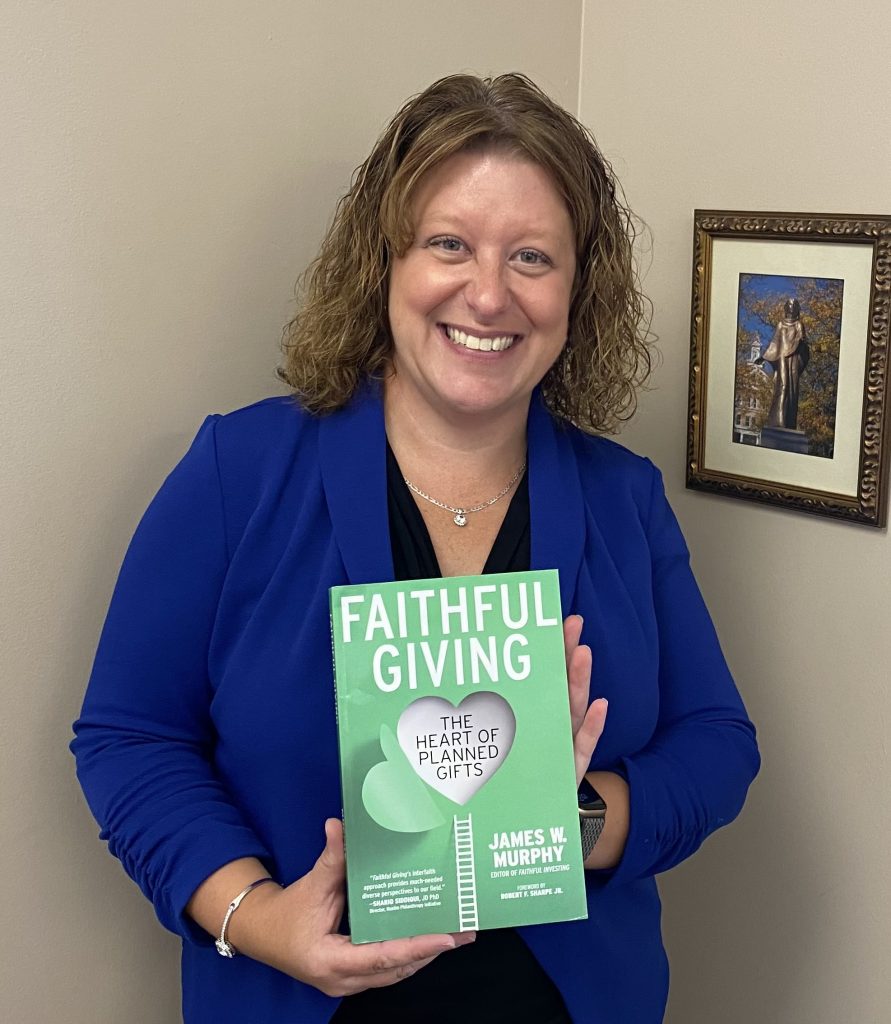Development Director Amy Palmer Contributes Chapter to Book on Faith-based Planned Giving
For many people, asking for money – even for an organization or cause they believe in – can be a challenge, and so can discussing death. Yet, some members of faith-based communities are charged with doing both as they ask benefactors to consider a planned gift – a donation left in a will or other estate plans.
In a chapter in the newly published book, Faithful Giving: The Heart of Planned Gifts, Amy Palmer, Director of Development for the Adrian Dominican Sisters, shares her own experience of asking donors for a planned gift and offers strategies to help others in this effort. The book, written by James W. Murphy, includes chapters to guide leaders and case studies written by people of diverse faith traditions who seek planned gifts from other members of their faith community.
“The main message is that it doesn’t matter how large or small your organization is,” Amy said in a recent interview. “It’s about building relationships with donors and understanding their passion. I wanted to write a very simple article about how to go about asking for a planned gift because it can be very scary. I wanted to make it as easy as possible, using strategies that have worked for me.”
Amy suggests going beyond tracking the amount of money raised and also tracking the number of phone calls made, the number of emails sent, and the number of visits conducted. She notes her own practice of sending donors birthday and anniversary cards, calling to thank them for donations, and even sending a get-well card after a donor has surgery. These are specific tools to help develop relationships, she said.
In the book, Amy relates her own experience of visiting with a donor couple in their home and asking them to consider a planned gift. The couple decided at first that they didn’t want to give a planned gift out of fear that not enough would be left for their children. After his wife’s death, the husband realized that his estate would provide enough for both his children and the Adrian Dominican Sisters and he agreed to the planned gift.
People just getting started in fun-raising might feel awkward asking for money, but Amy sees her work as going beyond the financial aspects. “It’s asking people to be part of a mission, of a ministry that’s a lot larger than us,” she said.
A development professional for 20 years, Amy said she “fell in love with the fact that you can help people in such a concrete way by working in the area of fundraising – the people who benefit from the organization.” In the case of the Adrian Dominican Sisters, Amy said the benefit is “multi-layered,” because donations help the Sisters and the people the Sisters minister to throughout the world. “Our fundraising efforts have such a huge impact across the globe,” she said.
Book editor James W. Murphy said Amy was recommended to him by Sister Patricia Daly, OP, a Caldwell Dominican Sister who had contributed to his earlier book, Faithful Investing. He said he was grateful to Amy for writing her chapter. “Her story is very valuable and will be valuable to Catholics and other faiths,” he said. “She wrote a very heart-felt piece.”
“The main purpose in writing the book is to empower congregational leaders as well as the leaders of smaller religious entities to raise these special kinds of gifts,” Jim said. He noted that the Adrian Dominican Congregation is fortunate to have a professional development director, but many congregations and religious organizations do not have that advantage. “Many rely on volunteers to do that work,” and asking for money – and discussing death – can be intimidating for volunteers, he said.
Jim spoke of the essentials of raising money: building trust, developing relationships, thanking people for their generosity, and adopting a “simple conscious awareness” of the situation of the donor who is involved.
While these essentials appear to be universal, Jim said that there are differences in the focuses of various faith traditions. His emphasis in the book is to “know thyself and know one’s constituents” within your faith tradition. The chapters provide guidance for creating and sustaining a planned giving effort and each case study draws on the experience of a volunteer or development professional from a different faith tradition – and each faith tradition can have a unique perspective, Jim said.
“Some faith traditions, especially Islam, are really focused on giving while you’re living,” he pointed out. The Sikh tradition also focuses on giving during a lifetime. “Our book focuses on inculcating a sense of giving beyond one’s lifetime, especially in the United States, where people have had the opportunity to build up [their financial resources] in their lifetime.”
Jim noted that people of faith often have a strong connection to their own congregation. It is this connection that makes it likely that they would be willing to leave their faith community in their estate plans.
“The big secret is that the wealthy are not the big planned givers,” he said. “Most who give these gifts are ordinary people, but they believe so much in their faith tradition that they raise [it] to the level of family in their estate plans.”
Jim writes from the experience of working with the Episcopal Church in the United States – developing new resources and giving webinars to empower leaders to reach out and ask Episcopalians to partner with them. “Over half of Americans don’t have a will,” he said. “This is a ministry opportunity for the congregation to help those people who haven’t made those decisions.”
 USA
USA



